Separation Anxiety and Dogs
Separation anxiety is a disorder when someone is afraid of losing or being away from a person or other figures. Separation anxiety is not only a disorder in human beings but also in dogs. Many dogs experience separation anxiety.
Separation anxiety in dogs happens when the dog who is overly attached to the owner is left alone on his own. Due to the stress of being left alone, they show destructive behaviours. Separation anxiety in dogs is a serious issue to be addressed.
Signs Your Dog Shows When They Have Separation Anxiety
When your dog has been left alone away from the person they are attached to or overly dependent upon they start showing distressed behaviours. They become hyperactive and show destructive behaviours. Many people regard this activity as the dog being mischievous but that really is not the case.

Image Source: spca.bc.ca
A dog with separation anxiety might:
- Show destructive behaviour like chewing up the furniture, scratching the doors and windows
- Wee or poop inside the house even though they are potty trained.
- Whine, howl or bark excessively
- Pant and circle around the house
- Drool way more than normal
- Try to escape away from the area where the dog is confined.
If your dog shows the above signs then it is confirmed that your dog has separation anxiety. To know about the activities your dog does when left alone you can put cameras around the house and know whether your dog has separation anxiety or not.
How Do Dogs Develop Separation Anxiety?
There is no specific reason for how separation anxiety in dogs is developed. Most of the cases of separation anxiety are seen in dogs who are adopted. A dog raised in a family since puppyhood is less likely to have separation anxiety. Some of the common reasons for separation anxiety in dogs are:
- When the household changes
- When the guardian or the owner changes
- When there is a change in the schedules
How To Treat Separation Anxiety In Dogs?
There are methods to overcome the separation anxiety of your dogs. Some solutions and treatments are listed below:
Counterconditioning
Counterconditioning is a training method in dogs which aims to change the response and behaviour of the dog towards stimuli completely different from the original behaviour and response they show. It is also a kind of behaviour therapy in dogs.
For example: When your dog shows signs of fear at a certain place think of ways to make the dog feel happy in that place. Like giving treats or making the dog do activities that they love. If this behaviour is repeated many times your dog can leave behind the fear of that place and learn to be happy in that place.
Exercise
Exercise is equally helpful for treating your dog’s separation anxiety. Both physical, as well as a mental exercise, can be helpful. When you make your dog exercise they get tired and may want to rest and will have no time to think so otherwise. So, so it can be easy to leave your tired dog with no signs of separation anxiety. Brain exercise can also be helpful to treat separation anxiety.
Medications
Training, counterconditioning and exercise alone may not be effective for the treatment of separation anxiety. Sometimes medications also can be equally important. The most common medication for dogs with separation anxiety recommended by a vet is amitriptyline, it is a medication which is used for the treatment of depression, anxiety and panic disorders.
It is also important you consult your vet while giving your dog any kind of medication.
Developing Independency
When being with your pet don’t be overly clingy and teach your dog independency. Let your dog be alone for some time rather than always staying with them every time you are home. When you leave your house just calmly and naturally leave the house with no exaggerations. When you return home just don’t be very loving towards your dog and play it very cooly. This can help reduce the separation anxiety in your dog.
Visit Dog Lime for more dog-related content!
Tags










